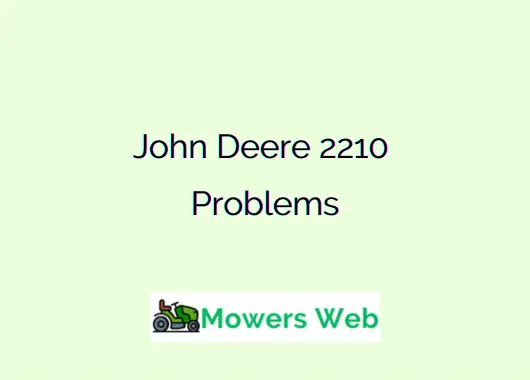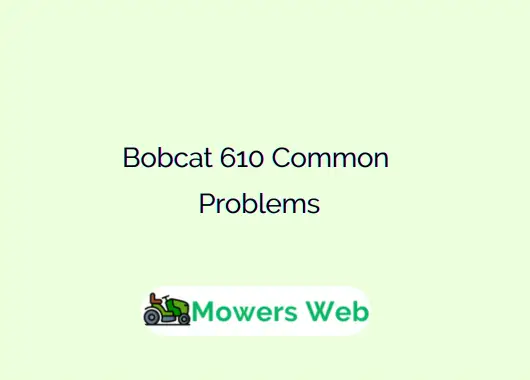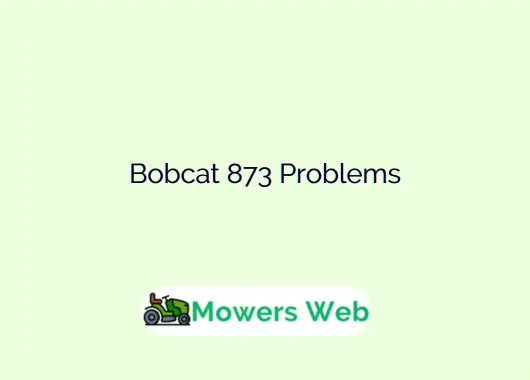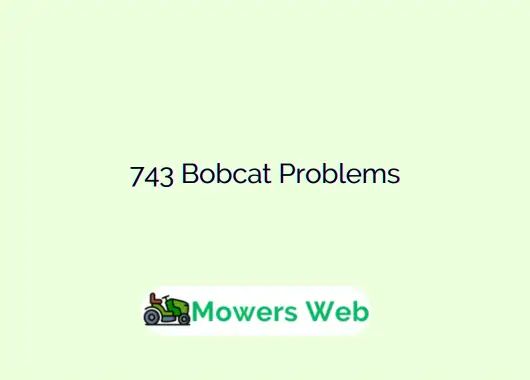The John Deere 2210 is a compact utility tractor, manufactured between 2003 and 2006, renowned for its versatility and reliability in tasks such as mowing, snow plowing, tilling, and hauling. However, like any piece of machinery, the John Deere 2210 is not immune to issues. Below, we explore the most common problems and solutions. Let’s jump in.
John Deere 2210 Problems
1. Engine Starting Issues
One of the most frequently reported problems with the John Deere 2210 is difficulty starting the engine or the engine failing to start altogether. This issue often stems from fuel delivery problems, such as clogged fuel filters or damaged fuel injectors.
Old or contaminated fuel can also prevent the engine from starting, especially if the tractor has been sitting unused for an extended period. A damaged or worn cylinder block may further contribute by reducing engine compression, making starting difficult.
Solutions:
- Check Fuel Quality: Ensure the fuel tank contains fresh, clean diesel fuel. Replace any stale fuel from previous seasons.
- Inspect Fuel Filters: Clean or replace clogged fuel filters to restore proper fuel flow.
- Clean Fuel Injectors: Use a recommended fuel line cleaner to clear clogs. Replace injectors if they show signs of damage.
- Examine Cylinder Block: If compression issues persist, inspect the cylinder block for wear or damage and replace faulty components.
Related John Deere 2010 problems(9 Common + Solutions)
2. Power Loss
Engine power loss is another common issue, often noticed during operation when the tractor struggles to maintain performance. This can result from a clogged air filter restricting airflow, carbon deposits in fuel injectors, or incorrect fuel injection pressure, leading to rough running or excessive smoke.
Solutions:
- Clean or Replace Air Filter: Regularly check and clean the air filter, replacing it if heavily clogged.
- Service Fuel Injectors: Clean injectors to remove carbon deposits. Replace them if damaged.
- Adjust Fuel Injection Pressure: Refer to the operator’s manual to ensure the correct pressure settings for optimal engine performance.
- Avoid Overloading: Operate the tractor within its capacity to prevent strain on the engine.
Related John Deere X380 Problems(8 Common + Solutions)
3. Transmission Problems
Transmission issues, such as gear slippage, rough shifting, or noisy operation (whining or grinding), are commonly reported. These problems are often caused by low or contaminated transmission fluid, worn gears, bearings, or clutch components, or misaligned transmission parts. Overheating of transmission oil due to inadequate fluid levels or clogged filters can also contribute to these issues.
Solutions:
- Check Transmission Fluid: Ensure fluid levels are adequate and replace contaminated fluid to restore lubrication.
- Inspect Components: Check clutch, bearings, and gears for wear or damage, replacing as needed.
- Clean or Replace Oil Filter: A clogged filter can cause overheating; clean or replace it to maintain proper fluid flow.
- Tighten Bolts: Ensure bolts securing the transmission shaft are tight to prevent misalignment.
- Avoid Abrupt Gear Changes: Shift gears smoothly and stop the tractor before changing to reduce strain.
Related 5 common John Deere 5045D Problems(With Solutions)
4. Hydraulic System Failures
The hydraulic system, critical for operating attachments like the front-end loader or 3-point hitch, can experience issues such as low pressure, unresponsive attachments, or jerky movements. Common causes include low hydraulic fluid levels, air trapped in the system, worn seals, or a faulty hydraulic pump.
Solutions:
- Check Fluid Levels: Regularly inspect and top up hydraulic fluid with the recommended type.
- Inspect Hoses and Seals: Replace any damaged or leaking hoses and seals to prevent fluid loss.
- Bleed the System: Remove trapped air to restore smooth hydraulic operation.
- Examine Hydraulic Pump: Inspect the pump for wear and replace it if necessary.
- Warm Hydraulic Fluid: If operating in cold conditions, warm the fluid to achieve the correct viscosity.
Related 9 Common John Deere 1026R Problems(With Solutions)
5. PTO (Power Take-Off) Issues
PTO problems, such as failure to engage or abrupt stopping when disengaged, are frequently reported. These can result from a faulty PTO solenoid, clutch pack, bearings, or switch. An abrupt PTO stop can also cause belts to slip or mower blades to detach.
Solutions:
- Test PTO Solenoid: Use a multimeter to check the solenoid’s voltage. Repair wiring or replace the solenoid if faulty.
- Inspect PTO Components: Check the clutch pack, bearings, and shaft for wear or damage and replace as needed.
- Ensure Proper PTO Shaft Play: Verify that aftermarket or incorrectly attached implements allow sufficient telescoping play to avoid pressure on the PTO.
- Consider PTO Overrunning Clutch: For abrupt stops, installing an overrunning clutch can allow a smoother disengagement.
6. Steering Difficulties
Steering issues, such as stiff or unresponsive steering, are often linked to a worn steering column, air in the steering system, or a defective control valve. These problems can make the tractor difficult to maneuver, especially during heavy use.
Solutions:
- Adjust or Replace Steering Column: If worn, adjust or replace the steering column.
- Bleed Steering System: Remove air from the system to restore smooth steering.
- Check Control Valve: Inspect and replace a faulty control valve to regain power steering functionality.
Related John Deere Power Reverser Transmission Problems(Fixed)
7. Electrical System Faults
Electrical issues, such as a battery that won’t charge, low RPM, or faulty wiring, are common. Corroded battery terminals, a defective voltage regulator, or worn wiring can disrupt electrical components, leading to starting or operational issues.
Solutions:
- Clean Battery Terminals: Use a wire brush or baking soda paste to remove corrosion.
- Check Voltage Regulator: Use a multimeter to verify proper voltage output and replace the regulator if faulty.
- Inspect Wiring: Replace worn or damaged wires and ensure tight connections.
- Test Battery: Charge or replace the battery if it cannot hold a charge.
Related John Deere Combine Settings Chart(Ultimate Guide)
8. Drive Shaft and U-Joint Issues
The drive shaft, particularly the U-joints, can be problematic due to difficult-to-access grease fittings, leading to inadequate lubrication and eventual wear. Some owners report needing to cut holes in the floorboards to grease the U-joints.
Solutions:
- Lubricate U-Joints: Use a needle greaser to access tight fittings. Consider cutting a small access hole if necessary.
- Install Fan Guard: Use John Deere’s fan guard (part number LVU19906) to protect the drive shaft and fan.
- Replace Worn U-joints: Replace U-joints showing signs of wear, especially after 500 hours of use.
9. Tire Problems
Tire wear or punctures, particularly on the front tires, are common due to heavy use or debris like thorns. Uneven tire sizes or incorrect pressure can also affect stability.
Solutions:
- Check Tire Pressure: Maintain proper tire pressure as per the operator’s manual.
- Replace Worn Tires: Replace damaged or worn tires promptly to avoid operational issues.
- Use Appropriate Tires: Switch to R1 tires for better traction if using turf tires for heavy tasks.
Related John Deere Tire Pressure Chart(For All Models)
Preventive Maintenance Tips
Many of these issues can be mitigated with regular maintenance:
- Follow the manufacturer’s maintenance schedule for oil changes, filter replacements, and fluid checks.
- Use high-quality diesel fuel and store it properly to prevent contamination.
- Regularly inspect hydraulic and transmission systems for leaks or wear.
- Keep electrical connections clean and secure.
- Avoid overloading the tractor or using it beyond its intended capacity.
Final words
The John Deere 2210 is a reliable and versatile tractor, but it’s not without its challenges. By understanding common problems such as engine starting issues, power loss, transmission troubles, hydraulic failures, PTO malfunctions, steering difficulties, electrical faults, drive shaft issues, and tire problems, owners can take proactive steps to maintain their tractors’ optimal performance.
For complex issues, consult a qualified technician or an authorized John Deere service center. With proper care, your 2210 can remain a dependable workhorse for years to come.




